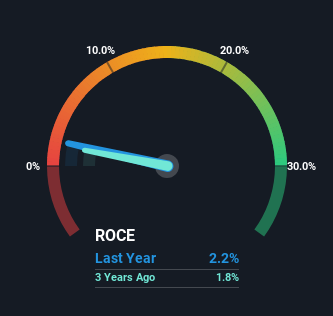Finding a business that has the potential to grow substantially is not easy, but it is possible if we look at a few key financial metrics. In a perfect world, we’d like to see a company investing more capital into its business and ideally the returns earned from that capital are also increasing. Put simply, these types of businesses are compounding machines, meaning they are continually reinvesting their earnings at ever-higher rates of return. Having said that, from a first glance at Dun & Bradstreet Holdings (NYSE:DNB) we aren’t jumping out of our chairs at how returns are trending, but let’s have a deeper look.
Understanding Return On Capital Employed (ROCE)
For those that aren’t sure what ROCE is, it measures the amount of pre-tax profits a company can generate from the capital employed in its business. Analysts use this formula to calculate it for Dun & Bradstreet Holdings:
Return on Capital Employed = Earnings Before Interest and Tax (EBIT) ÷ (Total Assets – Current Liabilities)
0.022 = US$179m ÷ (US$9.3b – US$975m) (Based on the trailing twelve months to June 2023).
So, Dun & Bradstreet Holdings has an ROCE of 2.2%. In absolute terms, that’s a low return and it also under-performs the Professional Services industry average of 12%.
See our latest analysis for Dun & Bradstreet Holdings

Above you can see how the current ROCE for Dun & Bradstreet Holdings compares to its prior returns on capital, but there’s only so much you can tell from the past. If you’re interested, you can view the analysts predictions in our free report on analyst forecasts for the company.
How Are Returns Trending?
In terms of Dun & Bradstreet Holdings’ historical ROCE movements, the trend isn’t fantastic. Around five years ago the returns on capital were 45%, but since then they’ve fallen to 2.2%. However it looks like Dun & Bradstreet Holdings might be reinvesting for long term growth because while capital employed has increased, the company’s sales haven’t changed much in the last 12 months. It may take some time before the company starts to see any change in earnings from these investments.
On a related note, Dun & Bradstreet Holdings has decreased its current liabilities to 11% of total assets. So we could link some of this to the decrease in ROCE. Effectively this means their suppliers or short-term creditors are funding less of the business, which reduces some elements of risk. Some would claim this reduces the business’ efficiency at generating ROCE since it is now funding more of the operations with its own money.
The Bottom Line
Bringing it all together, while we’re somewhat encouraged by Dun & Bradstreet Holdings’ reinvestment in its own business, we’re aware that returns are shrinking. And in the last three years, the stock has given away 64% so the market doesn’t look too hopeful on these trends strengthening any time soon. All in all, the inherent trends aren’t typical of multi-baggers, so if that’s what you’re after, we think you might have more luck elsewhere.
Dun & Bradstreet Holdings does have some risks, we noticed 3 warning signs (and 1 which doesn’t sit too well with us) we think you should know about.
While Dun & Bradstreet Holdings isn’t earning the highest return, check out this free list of companies that are earning high returns on equity with solid balance sheets.
Have feedback on this article? Concerned about the content? Get in touch with us directly. Alternatively, email editorial-team (at) simplywallst.com.
This article by Simply Wall St is general in nature. We provide commentary based on historical data and analyst forecasts only using an unbiased methodology and our articles are not intended to be financial advice. It does not constitute a recommendation to buy or sell any stock, and does not take account of your objectives, or your financial situation. We aim to bring you long-term focused analysis driven by fundamental data. Note that our analysis may not factor in the latest price-sensitive company announcements or qualitative material. Simply Wall St has no position in any stocks mentioned.
Source link
credite

